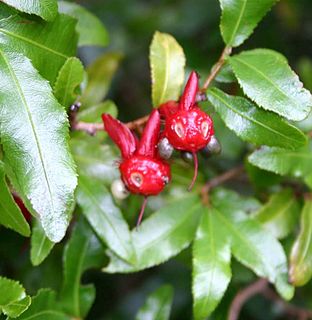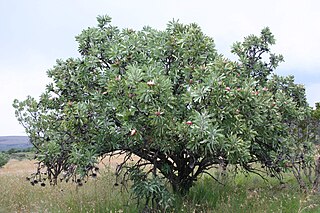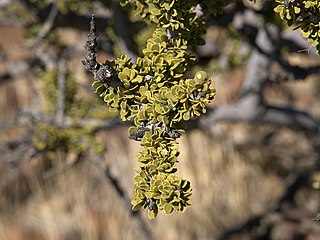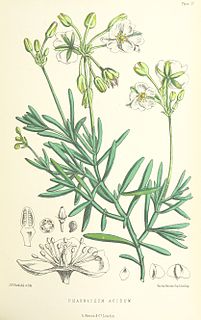
Veld, also spelled veldt, is a type of wide open rural landscape in Southern Africa. Particularly, it is a flat area covered in grass or low scrub, especially in the countries of South Africa, Lesotho, Eswatini, Zimbabwe and Botswana. A certain sub-tropical woodland ecoregion of Southern Africa has been officially defined as the Bushveld by the World Wide Fund for Nature. Trees are not abundant—frost, fire and grazing animals allow grass to grow but prevent the build-up of dense foliage.

Thespesia is a genus of 13 flowering shrubs and trees in the Hibiscus family, Malvaceae, although within the family they are more closely related to cotton plants (Gossypium). The genus is distributed from the South Pacific through Asia, Africa, and the Caribbean.

Ochna is a genus comprising 86 species of evergreen trees, shrubs and shrublets belonging to the flowering plant family Ochnaceae. These species are native to tropical woodlands of Africa, the Mascarenes and Asia. Species of this genus are usually called ochnas, bird's-eye bushes or Mickey-mouse plants, a name derived from the shape of the drupelet fruit. The name of this genus comes from the Greek word Ochne, used by Homer and meaning wild pear, as the leaves are similar in appearance. Some species, including Ochna integerrima and O. serrulata, are cultivated as decorative plants.

The ring-necked dove, also known as the Cape turtle dove or half-collared dove, is a widespread and often abundant dove species in East and southern Africa. It is a mostly sedentary bird, found in a variety of open habitats. Within range, its penetrating and rhythmic, three-syllabled crooning is a familiar sound at any time of the year. Its name is derived from the semi-collar of black feathers on the lower nape, a feature shared with a number of Streptopelia species. Like all doves, they depend on surface water. They congregate in large flocks at waterholes in dry regions to drink and bathe.

Silene undulata is a plant native to the Eastern Cape of South Africa.

Boscia albitrunca, commonly known as the shepherd tree or shepherd's tree, is a protected tree in South Africa. The species epithet "albitrunca" refers to the oftentimes white trunk. Traditionally, the shepherd tree was used by Dutch settlers, "boers", to create a variant of coffee that is derived from the roots of the tree. It is an evergreen tree native to southern and tropical Africa, living in the hot, dry, and often brackish low-lying areas, sometimes on abundant lime or occasionally found in rocky terrain. It is a common tree of the Kalahari, bushveld and lowveld. It is one of the most important forage trees in the Kalahari.

Protea caffra, native to South Africa, is a small tree or shrub which occurs in open or wooded grassland, usually on rocky ridges. Its leaves are leathery and hairless. The flower head is solitary or in clusters of 3 or 4 with the involucral bracts a pale red, pink or cream colour. The fruit is a densely hairy nut. The species is highly variable and has several subspecies.

Protea welwitschii is a species of shrub or small tree which belongs to the genus Protea, and which occurs in bushveld and different types of grassland.

Boscia is a genus of plants in the family Capparaceae. It contains the following species:

Boscia senegalensis, commonly known as hanza, is a member of the family Capparaceae.

Conospermum taxifolium, commonly known as variable smoke-bush, yew-leaf smoke bush or paint brush, is a plant in the family Proteaceae and is endemic to eastern Australia. It is an erect shrub with narrow elliptic to narrow egg-shaped leaves with the narrower end towards the base and panicles of cream-coloured to white, tube-shaped flowers.

Hyphaene petersiana, the real fan palm or makalani palm, is a palm tree native to the subtropical, low-lying regions of south central Africa.

Peninsula Granite Fynbos is an endangered Fynbos vegetation type which is endemic to the city of Cape Town and occurs nowhere else. It is a unique type of tall, dense and diverse scrubland, scattered with trees. It can be found all along the belt of granite that encircles Table Mountain.

Boscia foetida, commonly known as the stink shepherd's tree and the smelly shepherd's bush, is an evergreen shrub or tree that is native to the warmer and drier parts southern Africa. It is found in semi-desert and arid bushveld, and in the west it occurs commonly in areas which are otherwise sparsely wooded. It is known for the particularly unpleasant smell of its flowers which appear during early spring, to which its specific name foetida alludes. Its freshly cut wood likewise has an unpleasant smell, and has traditional medicinal and magical uses, for instance as a protection against lightning. In central Botswana the village of Mopipi is named after this species.

Kewa is a genus of flowering plants, consisting of eight species of succulent sub-woody plants, native to eastern and southern Africa, including Saint Helena and Madagascar. These are small shrubs or herbs that form cushions and have edible, acid-tasting leaves. Kewa is the only genus in the family Kewaceae.

Protea magnifica, commonly known as the queen protea, is a shrub, which belongs to the genus Protea within the family Proteaceae, and which is native to South Africa.

Aspilia mossambicensis, also known as wild sunflower, is a medicinally useful herbaceous plant of the family Compositae (Asteraceae). It is widespread with an anthropogenic distribution in central and Eastern tropical Africa from Ethiopia, through East Africa, the Congo, Zambia, Zimbabwe, Malawi, Mozambique and South Africa.
Herb or shrub 0.5–1 m or straggling bush to 2.5 m high; branches scabrid. Leaves sessile to shortly petiolate, ovate or elliptic, 2–12´1–3 cm, base cuneate, margins entire or serrate, apex acute or attenuate, scabrid on both surfaces, somewhat 3‑nerved from base; petiole up to 1 cm long. Capitula in loose paniculate corymbs, on stalks to 7 cm long; involucre 4–7 mm high; outer phyllaries yellowish near base, green near apex, hispid‑pubescent; paleae 5–7 mm long, keeled with a dark midrib. Ray florets 8–13, bright yellow, rays 6–20 mm long, glabrous or pubescent above; disk florets yellow, 5–6.5 mm long, often with dark stripes along the tube. Achenes brown, obovoid, 4–5 mm long, pilose; pappus of several connate scales to 0.4 mm long and 1–2 barbellate aristae 1–3 mm long.

Protea foliosa, also known as the leafy sugarbush, is a flowering plant of the genus Protea in the family Proteaceae which is endemic to the Cape Region of South Africa. In the Afrikaans language it is known as ruie-suikerbos.

Protea punctata, also known as the water sugarbush or water white sugarbush, is a shrub belonging to the genus Protea which is found growing in the wild in South Africa.



















